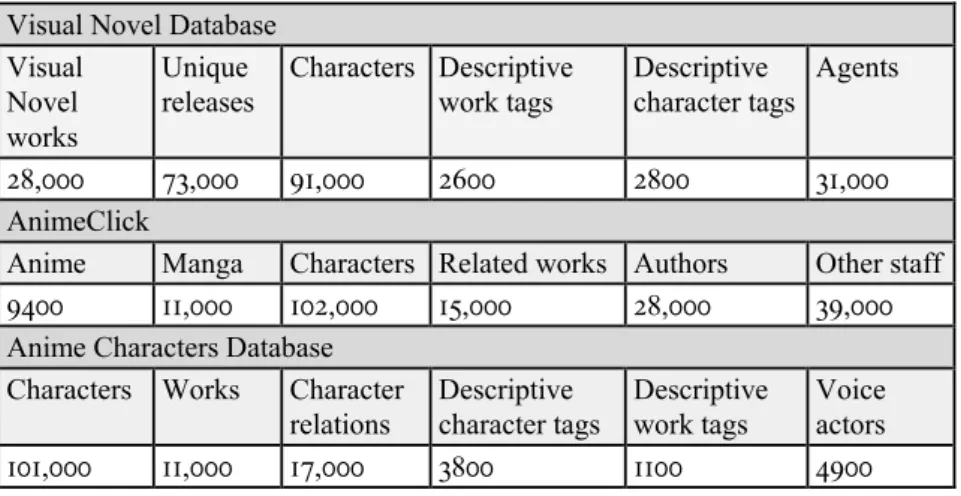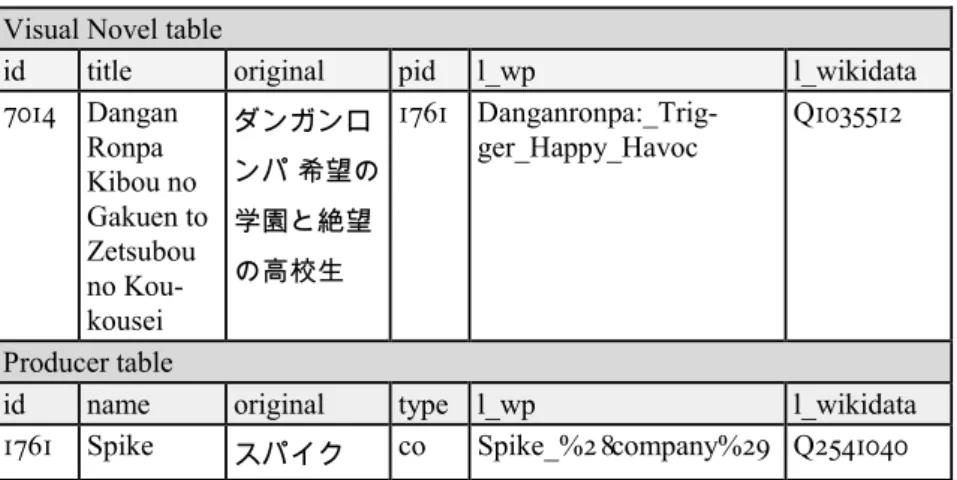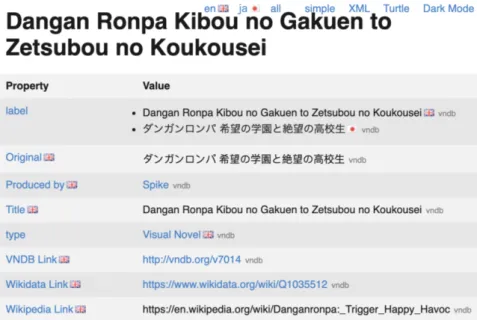The Benefits of RDF and External Ontologies for Heterogeneous Data
A Case Study Using the Japanese Visual Media Graph
Senan Kiryakos, Magnus Pfeffer
Stuttgart Media University, Germany {kiryakos, pfeffer}@hdm - stuttgart.de
Abstract
Across numerous fan created and curated websites, there exists a wealth of se- mantically rich descriptive data for a variety of Japanese visual media, such as anime, manga, and video games. The amount and granularity of these data makes it valuable for domain researchers, but the semantic heterogeneity and lack of interconnectedness makes analysis cumbersome. Seeking to address this issue, the Japanese Visual Media Graph ( JVMG ) project aims to create a type of global database built using RDF and external ontologies to better enable data - driven research in the domain. We discuss the benefits this approach has when com- pared to the local relational databases used at the fan - sites, such as enabling the easy creation of aggregate resources using data from multiple providers, and the ability to constantly update and alter a schema over time. This encourages the incorporation of additional data in the future, while still maintaining rich data semantics and provenance. While many of the benefits are discussed in the con- text of the JVMG project or the Japanese visual media domain, we discuss how this database approach may be similarly advantageous to other projects that seek to create aggregate resources, or collect heterogeneous data from diverse sour - ces.
Keywords: ontology-based data access; semantic heterogeneity; knowledge
graph; fan-curated data; digital humanities
1 Introduction
For researchers interested in Japanese visual media (e. g., anime, manga, vid- eo games), the largest collection of semantically rich descriptive data exists not at existing memory institutions, but across a multitude of fan-created and curated websites. These data are abundant, highly granular, multilingual, and provide a rich source for which data - driven research can be conducted. The nature of these data make it valuable for researchers studying various aspects of the Japanese visual media domain, such as themes, genres, and characters, as well as trends, receptions, and influences. In attempting to better meet the needs of researchers, the Japanese Visual Media Graph ( JVMG ) project (Pfeffer & Roth, 2019) seeks to utilize this community-created data to devel- op a graph - based, highly interconnected database (i. e., a type of knowledge graph), combined with flexible and powerful querying and analytical tools. 1 It should be noted that while the database may contain some links to visual media found at the original data providers, the primary contents of the data- base are descriptive metadata and not the visual materials themselves.
The desire to utilize this fan-created data in an interconnected database poses several issues, but also unique opportunities. Relying on multiple data providers means the data is fairly heterogeneous, available in different for- mats, covering diverse entity levels, described according to different data models, and using different vocabularies. Thus, the integration of this dispar- ate data into a single database involves significant data transformation, prop- erty mapping, the identification of related or identical resources, and the creation of a unified global ontology. Though a challenge, this integration presents us with unique opportunities, such as merging related resources with data sourced from multiple providers, developing a more formal data model and ontology for the domain of Japanese visual media, and exploring differ- ent ways of making these data accessible to, and able to be queried by, researchers.
In detailing this database approach, this paper outlines the issues and opportunities encountered by the JVMG project thus far, and highlights the advantages and disadvantages presented when using a database that relies on
1 The database is currently for internal use and will be made more publicly available
later this year. Up - to - date information on the state of the project and means of access
will be published on the project homepage https://jvmg.iuk.hdm-stuttgart.de/.
linked data formats and external ontologies. We discuss the benefits that this approach has had for primary aspects of our project specifically, such as the integration of heterogeneous data, and the creation of aggregated resources, while also presenting this approach as one that may be of interest to projects with similar goals regarding data integration.
Following this introduction, Section 2 describes the data providers, the type of data being collected and integrated, and data processing. Section 3 outlines the differences between databases currently used with these data and the approach we use, along with discussing two specific advantages. Lastly, we conclude with thoughts and future plans in Section 4.
2 Data providers
In order to aid those seeking to conduct data - driven research on the Japanese visual media domain, a large amount of descriptive data is required. The best source of these data can change depending on the domain. Memory institu- tions, such as libraries or archives, for example, contain a wealth of data for more traditional literary materials, though this is often of a limited granula - rity due to factors such as cataloguing rules. Past research (e. g., Kiryakos et al., 2017) has shown that for media types like anime, manga, and video games, the best source of data is instead found across a variety of hobbyist webpages. The amount of data is not only vast, but extremely granular, as communities with various interests and perspectives describe the same mate- rials in distinct ways.
As such, we rely on these communities, several of whom we have made
formal collaboration agreements with, to utilize their data. These partners
include the Anime Characters Database, AnimeClick, and the Visual Novel
Database ( VNDB ). Other sources that allow for open data use, such as Wiki-
data, are also utilized. Though the coverage and contents of these sites differ,
they generally contain traditional descriptive data, such as titles, creators, and
dates, along with more granular data such as genres and tags, character lists
and traits, relationships between related entities (e. g., characters or creative
works), and organizational provenance. The amount of some of these data is
shown in Table 1. This is the type of information that we seek to leverage to
make data - driven research questions regarding Japanese visual media more
easily investigated. Before doing so, however, work on the data must be per-
formed, as the communities provide us with data in different ways, using different formats, and according to their own individual data models and vocabularies. Though a detailed description of the data transformation pipe- line is outside the scope of this paper, an outline of this transformation will help better illustrate how the data comes to be integrated and connected in our database.
Table 1: Approximate numbers of various data collected from providers Visual Novel Database
Visual Novel works
Unique
releases Characters Descriptive
work tags Descriptive
character tags Agents
28,000 73,000 91,000 2600 2800 31,000
AnimeClick
Anime Manga Characters Related works Authors Other staff
9400 11,000 102,000 15,000 28,000 39,000
Anime Characters Database Characters Works Character
relations Descriptive
character tags Descriptive
work tags Voice actors
101,000 11,000 17,000 3800 1100 4900
Data transformation and ontology creation
Our data is sourced in a variety of ways, e. g., as data dumps or through API s, depending on the provider, and is typically either in the form of SQL tables or JSON . As our database uses Resource Description Framework ( RDF ) seri- alizations, data transformation is the first technical step, though this is pre- ceded by an analysis of each provider to better understand their data model.
Conversion is done using Python, and is then processed using the RDFLib package. The resulting output is a series of RDF files able to be integrated and queried using the query language SPARQL . While other existing meth- ods of creating RDF output based on relational data exist (see, e. g., Arenas et al., 2012; Das et al., 2012), our method differs, as we do not create a mapping layer over the relational data, but instead ingest and transform it directly.
This processing is a central part of the data integration process, as
RDFLib allows us to define and output RDF triples using non - RDF input data
we receive from our data providers. Through an analysis of the data, an
ontology is created for each data provider, which includes a class structure
based on how resources are presented by a provider, and an accompanying RDF vocabulary file. At its most basic, an example of this vocabulary con- version would be the ‘title’ column header in an SQL table from the VNDB becoming <http://mediagraph.link/vndb/ont/title> – a prop- erty in our namespace that represents that same title column header. An ex- cerpt of this original tabular data from VNDB with limited properties is shown in Table 2, with its RDF transformation shown in Figure 1. While this RDF data is able to be queried using SPARQL , a separate RDF vocabulary file combined with our web frontend allows for these data to be displayed and browsed in a more human - readable way via a web browser; a sample page is shown in Figure 2.
Table 2: A sample of tabular data for a visual novel from VNDB Visual Novel table
id title original pid l_wp l_wikidata
7014 Dangan Ronpa Kibou no Gakuen to Zetsubou no Kou- kousei
ダンガンロ ンパ 希望の 学園と絶望 の高校生


